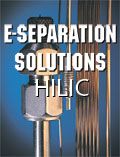The LCGC Blog: Chromatography Technical Tips - Hydrophilic Interaction Liquid Chromatography (HILIC)
E-Separation Solutions
The Technical Department at Crawford Scientific are regularly asked for analytical conditions or applications in the hydrophilic interaction liquid chromatography (HILIC) mode. Here?s a short primer on what you need to understand about this separation mode from a practical perspective, using some of the questions that we regularly get asked.
The Technical Department at Crawford Scientific are regularly asked for analytical conditions or applications in the hydrophilic interaction liquid chromatography (HILIC) mode. Here’s a short primer on what you need to understand about this separation mode from a practical perspective, using some of the questions that we regularly get asked:
When can HILIC chromatography give me an advantage?
Typically HILIC is used when retention times in reversed phase mode are insufficient, and this typically involves more polar or ionisable analytes (i.e. where log P values are below 0)
HILIC chromatography can be used as a replacement for Normal Phase chromatography and is particularly useful when using electrospray mass spectrometry as the analyte can be ionised in solution (ensure good ESI efficiency) whilst still showing good retention and the high organic content of the mobile phase ensures efficient droplet desolvation in the API interface of the LCMS.

Figure 1: General schema for analyte Log P value versus separation mode of choice(Adapted with permission from SIELC Technologies, Prospect Heights, Illinois, USA)
So how does HILIC mode work?
The exact mechanism of HILIC chromatography is still subject to a certain amount of speculation, however most experts agree that the bulk mechanism involves polar analyte partitioning into and out of a layer of water which is adsorbed (associated) onto the surface of the polar stationary phase. Although it is also widely understood that as well as this liquid/liquid partitioning behaviour, dipole – dipole and electrostatic interactions are also involved, especially where the eluent pH is adjusted so that the stationary phase surface is charged – predominantly via the anionic surface silanol species at pH >5.
Mobile phases for HILIC chromatography contain a high degree of organic solvent and a typical gradient in HILIC would involve altering the aqueous composition between 5 and 30%.
Content on this page requires a newer version of Adobe Flash Player.
Figure 2: More highly hydrophilic species (purple) partition into the water rich layer at the stationary phase surface. Interaction at the surface occurs through dipole-dipole and hydrogen bonding between the surface's functional groups and polar functional groups of the analyte.
Content on this page requires a newer version of Adobe Flash Player.
Figure 3: With an unbonded silica surface, and the eluent at pH ~ 5-9 and

.png&w=3840&q=75)

.png&w=3840&q=75)



.png&w=3840&q=75)



.png&w=3840&q=75)


